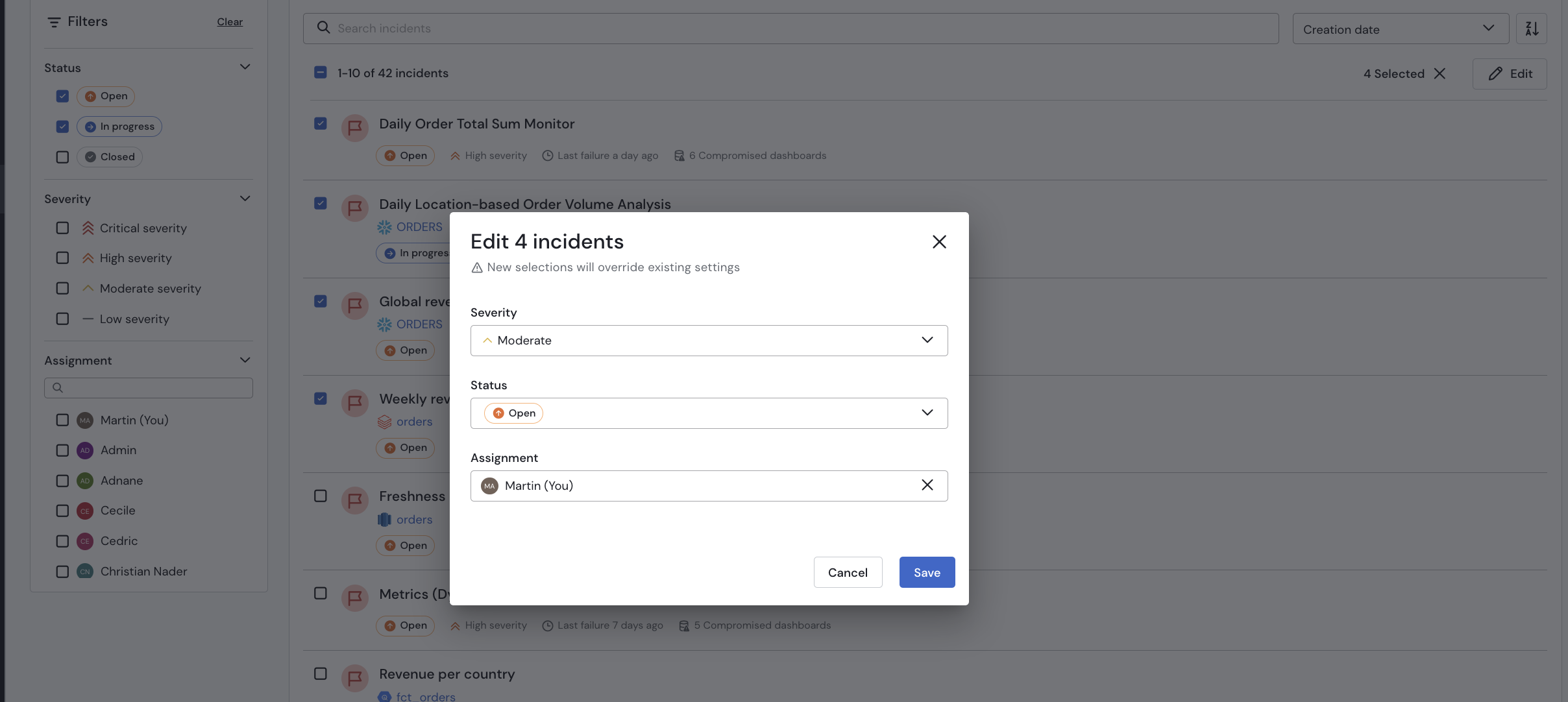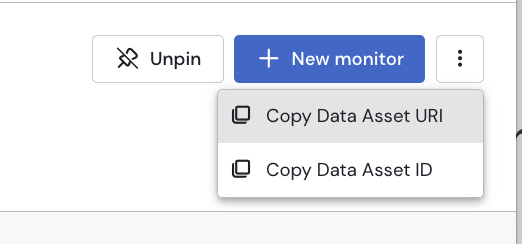Product Release 2024-07-02
✨ Feature Highlights
Batch Actions on Incidents
Managing Incidents is a big focus area for Sifflet at the moment as we know a lot of our customers want to manage incidents at scale! The new and improved Incident Search page allows you to now batch edit the Severity, Status and Assignments of incidents.

🔥 Improved Monitors as Code: For Loops and Templates
Many improvements to Monitors as Code today !
Alternative to Monitor UUIDs when defining monitors: friendlyId
friendlyIdBefore:
For each monitor a UUID needed to be specifiedid: 7edf1177-1a3c-4d71-b85f-e38b773735b4 which was often difficult since a UUID had to be generated outside of the yaml.
friendlyIdalternative
friendlyId is an alternate ID that only needs to be unique per dataset, this means a dataset cannot have two monitors with the same friendlyId.
kind: Monitor
version: 1
friendlyId: customerEmailUnique
datasets:
- name: sales
datasource:
name: mySqlDatabase
...The above monitor has a friendlyId customerEmailUnique , only one of those monitors can be added to the sales table in our mysqlDatabase.
Alternative method to reference Datasets: URIs
Before: Referencing Datasets required knowledge of information specific to Sifflet.
Sifflet ID of dataset:
datasets:
- id: 70217023-1a89-4c0b-9b6a-c85192c918b3Sifflet dataset name with either the id or the name of the datasource
datasets:
- name: Prices
datasource:
name: BigQuery Data warehouse ## OR
id: ce3e9dd9-b007-42b0-b884-8c419f7f6daaNow with URIs
URIs are a sifflet agnostic way to define dataset. Find out more about URIs
datasets:
- uri: snowflake://xyz12345.eu-central-1/DATABASE.SCHEMA.TABLE
URIsYou can retrieve URIs from the Catalog's Asset Page.
Multiple Monitors Per File
Before : One file per Monitor
Now : You can now separate monitors with the --- yaml separator and have multiple monitors on the same page
kind: Monitor
version: 1
friendlyId: customer_id_format_check
name: Matches Regex Monitor on CUSTOMER_ID
...
---
kind: Monitor
version: 1
friendlyId: customer_id_duplicate_check
name: Unicity Monitor on CUSTOMER_IDTemplates
Before Each monitor definition needed to contain all the information, this meant a lot of information had to be duplicated, such as tags or alerting.
Now Templates enable the definition of parameters that can be imported into new monitor definitions
Simply define a partial (or complete ) monitor definition with a templateName
templateName: missionCriticalTags
tags:
- name: Mission Critical
notifications:
- kind: Email
name: [email protected]
- kind: Slack
name: Alerts
id: dd6f06ec-fab1-4a87-9544-b113f496d61d
---
templateName: Unimportant
tags:
- name: UnimportantThis templateName can then be extended
kind: Monitor
version: 1
friendlyId: myMonitor
name: My Monitor
extends:
- missionCriticalTags
...
---
kind: Monitor
version: 1
friendlyId: myOtherMonitor
name: My Other Monitor
extends:
- Unimportant
...For Loops
Before Once again before each monitor had to be defined individually! However there are scenarios where I want to deploy the same monitor on multiple tables !
Now For loops allow you to define monitors on multiple tables easily !
for each dataset T:
datasets:
- uri: snowflake://sifflet-enterprise/DEMO.SE_ENV.ORDERS
- uri: snowflake://sifflet-enterprise/DEMO.SE_ENV.CUSTOMERS
- uri: snowflake://sifflet-enterprise/DEMO.SE_ENV.STG_CUSTOMERS
monitors:
- kind: Monitor
version: 1
friendlyId: customer_id_format_check
name: "[${T.name}]Format monitor on CUSTOMER_ID"
description: ""
incident:
severity: Low
message: ""
parameters:
kind: FieldFormat
field: CUSTOMER_ID
format:
kind: Regex
regex: "^[0-9a-f]{8}-[0-9a-f]{4}-[0-9a-f]{4}-[0-9a-f]{4}-[0-9a-f]{12}$"
...Wildcards and excludes
use include with * wildcards in your uris to apply to many datasets at the same time! then use exclude to exclude specific datasets
for each dataset T:
datasets:
include:
- uri: snowflake://xyz12345.eu-central-1/DATABASE.SCHEMA.*
- uri: bigquery:*.*.*ORDERS
exclude:
- uri: snowflake://xyz12345.eu-central-1/DATABASE.SCHEMA.MYTABLETOEXCLUDEDynamic Names
name: "[${T.name}]Format monitor on CUSTOMER_ID"
Use ${T.name} to reference the name of your table.
🛠 Fixes
- Fixed an issue where Sifflet pages would require a manual refresh to operate as expected after a new release
- Fixed an issue where in some instances, a recently edited user could not be saved
- Fixed an issue where some domains would not show up in the permissions modal.
App version: v279-281

